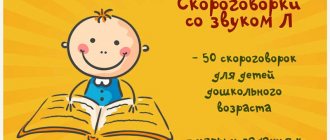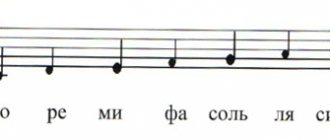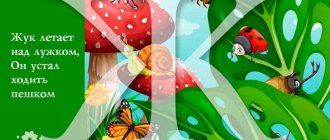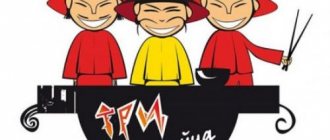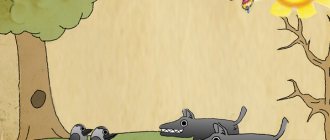Hard and soft consonants
Consonants are hard and soft. They are divided into paired and unpaired. Paired hard and paired soft consonants help us distinguish between words. Compare: horse [kon'] - kon [kon], bow [bow] - hatch [l'uk].
For understanding, let’s explain it “on the fingers”. If a consonant letter in different words means either a soft or hard sound, then the sound belongs to the pair. For example, in the word cat the letter k denotes a hard sound [k], in the word whale the letter k denotes a soft sound [k']. We get: [k] - [k'] form a hardness-softness pair. Sounds for different consonants cannot be classified as a pair, for example [v] and [k'] do not form a pair in terms of hardness-softness, but they do form a pair [v]-[v']. If a consonant sound is always hard or always soft, then it belongs to unpaired consonants. For example, the sound [zh] is always hard. There are no words in the Russian language where it would be soft [zh']. Since there is no pair [zh]-[zh'], it is classified as unpaired.
Tongue twisters with the sound Ш
- Our chess player will exceed your chess player, exceed your chess player.
- The cuckoo bought a tub and decided to give the cuckoos a bath.
- Ivashka has a shirt, the shirt has pockets, Pockets have a shirt, Ivashka has a shirt.
- Lyubasha has a hat, Polyushka has a bun, Pavushka has a boat, Ilyushka has a hockey stick.
- Timoshka Proshke crumbles crumbs into okroshka.
- On the window, a tiny midge is deftly caught by a cat with its paw.
- Masha washes her neck and ears in the shower.
- A hat and a fur coat - that’s our Mishutka.
- Masha sewed a fur coat, a hat and pants for the monkey.
Voiced and voiceless consonants
Consonant sounds are voiced and unvoiced. Thanks to voiced and voiceless consonants, we distinguish words. Compare: ball - heat, stake - goal, house - volume. Voiceless consonants are pronounced with the mouth almost closed; when pronouncing them, the vocal cords do not work. Voiced consonants require more air, the vocal cords work.
Some consonant sounds have a similar sound in the way they are pronounced, but are pronounced with different tonality - dull or voiced. Such sounds are combined in pairs and form a group of paired consonants. Accordingly, paired consonants are a pair of a voiceless and a voiced consonant.
- paired consonants: b-p, v-f, g-k, d-t, z-s, zh-sh.
- unpaired consonants: l, m, n, r, y, c, x, h, shch.
Tongue twisters for the sounds S, Сь, З, Зь
- Little Sanya's sleigh moves on its own. Little Sanya drives the sleigh on its own.
- Osa is barefoot and without a belt.
- Sanya took a sleigh up the hill, Sanya rode down the hill, and Sanya rode a sleigh.
- Sonya and Sanya have a catfish with a mustache in their nets. A catfish with a mustache in Sonya and Sanya's nets.
- Alesya is sitting with her legs dangling from the stove.
- They stomp, gander after gander, in single file. The gander looks down on the gander.
- Senya carries hay in the canopy, Senya will sleep in the hay.
- Evsey, Evsey, sift the flour.
- Zoya's bunny's name is Zaznayka.
- The violent Byaka is loud, Byaka Buka is threatening, Byaka Buka is insolent, Byaka Buka is pushing.
- On a winter morning, from the frost, the birch trees ring at dawn. Tongue twister A poplar was stomping along the road. Poplar was stomping towards Sevastopol, and Seva was stomping nearby. Poplar on the right, Seva on the left. Where is Seva with the poplar? Already near Sevastopol.
Paired and unpaired consonants
Consonant sounds (soft and hard, voiceless and voiced) are divided into paired and unpaired. The tables above show the division. Let's summarize everything with a diagram:
Scheme 2. Paired and unpaired consonant sounds.
To be able to do phonetic analysis, in addition to consonant sounds, you need to know
It is no coincidence that hissing consonant sounds received such an interesting name - they really seem to hiss, since they are pronounced in a special way. Our article for 2nd grade students talks about them in detail: what groups such sounds are divided into, what features and phonetic characteristics they have.
Tongue twisters for the sounds C, S
- The heron's chick clung tenaciously to the chain.
- Two colorful chickens are running along the street.
- Chicken and hen drink water on the street.
- An awl, a piece of soap, a crooked spindle, a silk towel - on the porch under the door.
- The horse clicked its hoof from behind, and dust swirled under the hoof.
- The young man asked the young woman for some water to drink.
- Water flows from a nearby well all day long.
- Starlings and tits are cheerful birds.
- There is a cart of oats, next to the cart is a sheep.
What are these sounds and how to pronounce them
Hissing sounds stand out from the rest by the acoustic noise they produce, that is, hissing. They can be pronounced correctly only with the lips open and slightly extended forward, while the teeth are almost closed. This creates a gap through which the air hisses. Thus, a striking example of a hissing consonant sound is the sound [ш], which is clearly pronounced in this way, without adding a voice. All four of these sounds are always pronounced while exhaling. At the same time, the sound does not pass from the sides: it is blocked by the tongue, pressed against the molars and hard palate. That is, in order to pronounce a hissing sound correctly, you need to “make” a ladle out of your tongue.
We can say that they are of a complex nature - they are difficult to pronounce not only for children, but also for many adults. To learn how to do this correctly, you need to monitor not only the position of your tongue and lips, but also the exhaled air: its stream passes approximately in the middle and should be wide enough. You can check this by raising your hand to your mouth.
If you monitor your articulation, you will notice that all hissing sounds are based on one thing - [w]. So, [g] appears if you add a voice to it, that is, trembling of the vocal cords. With [ш] the middle part of the tongue rises, and with [h] a stop in front of the labial-dental fissure is added to this rise.
Tongue twisters starting with the letter “R”
- There is grass in the yard, there is firewood on the grass. Don’t cut wood on the grass in the yard.
- Karl stole corals from Clara, Clara stole a clarinet from Karl.
- The ships tacked and tacked, but did not tack.
- Tell us about your purchases. What purchases are you talking about? About shopping, about shopping, About my shopping.
- The otter dived into the otter's bucket. The otter drowned in a bucket of water.
- The Greek was driving across the river, He saw the Greek - there was a cancer in the river. He put the Greek's hand in the river, Cancer grabbed the Greek's hand - tsap!
- In the depths of the tundra Otters in spats Poking into buckets Cedar kernels!
- Ripping the leggings off an otter In the tundra I'll wipe the kernels of the cedars with the otter I'll wipe the otter's face with the leggings Cannonballs in buckets Otter into the tundra!
Unpaired or paired?
The science of the Russian language considers the sounds [ch] and [sch] to be unpaired, and [zh] and [sh] to be paired only according to one attribute. And indeed, since there are other sounds that have a pair, they cannot be completely combined. However, there are two characteristics by which they can be combined into groups - voiced/voiceless and hard/soft. So, [zh] and [sh] are only hard sounds, and [h] and [sch] are soft. It doesn’t matter what vowels come after them. Even if you put a soft sign after the letter denoting a hard sibilant, the sound will be pronounced hard.
As for the division into voiceless and voiced, the first category includes [w], [h] and [sch], and the second - only [z], since when it is pronounced, a voice is added. Thus, [zh] and [sh] are paired on the basis of deafness/voice.
Once upon a time it was different - [f] and [w] were soft, but already from the 14th century they began to become the same as today, that is, hard.
Tongue twisters for the sounds R, L, Rь, L
- Polkan pushed the stick with his paw. Polkan pushed the stick with his paw.
- Mila's mother washed her with soap. Mila didn't like soap.
- The Christmas tree has pins and needles. Splitting needles near the Christmas tree.
- In the winter cold everyone is young. Everyone is young in the winter cold.
- Our regiment fell into a trap.
- The cat lapped milk, and Vitya dipped a bun in milk.
- The woodpecker was pecking at the oak tree, but didn't finish it.
- The cat rolled the ball of thread into the corner. The cat rolled a ball of thread into the corner.
- Have you washed the raspberries? They washed, but did not soap.
- They stomped and stomped, they stomped until they reached the poplar, they stomped until they reached the poplar, but they stomped their feet.
- Kolya stabs the stakes. Fields field flight.
- The field is not weeded, the field is not watered. The field needs to be watered, the field needs to be watered.
- Prokhor and Pakhom are riding on horseback. Prokhor and Pakhom are riding on horseback.
- Beavers go into the pine forests. Beavers are kind, beavers are cheerful.
Features of hissing sounds
Sibilants have their own characteristics when pronounced
. So, you need to tighten your lips and move them forward a little. They cannot be pronounced with closed lips, unlike some others (for example, M). The tip of the tongue is slightly pressed against the palate with its edges, leaving a small space in the center of the tongue. It is through this that the air passes, creating a hissing sound when pronounced.
Initially, hissing consonants were soft in the Old Russian language. They appeared as a result of the first palatalization, or when the combination of consonants with , ['zj] and other sounds changed.
The initial softness of these sounds determined the fact that in many literary monuments the letters that denoted them were pronounced followed by vowels or “ь”
, For example:
- husband;
- nessshi;
- hour;
- comfort, etc.
However, in the process of the formation of linguistic norms and adverbs, [w] and [zh] hardened, but “ch” still remained soft. The hardening of [w] took place around the 14th century. At this time, variants of writing the sounds [w] or [zh] with the letter “s” after them appeared in literary monuments. For example, “Shyshkin” or “hold.”
In modern language, it is traditional to write a soft sign at the end or the letter “and”
to denote the sound [s] in words such as:
- disturb;
- sew;
- rye, etc.
Combinations such as soft [schtsch] or [zhj], which were common in antiquity, then lost the explosive element in such combinations in words such as “I’m looking for” or “yeast.”
Tongue twisters for the letters V, P, G, K, T, D, V, F
- Dima gives Dina melons, Dima gives melons to Dina.
- The woman has beans, the grandfather has oaks.
- The road to the city is uphill, from the city - down the mountain.
- Boba has a screw, Vitya has a bandage.
- Fanya visiting Vanya. Vanya is visiting Fanya.
- From the clatter of hooves, dust flies across the field.
- There are five honey mushrooms standing by the stumps again.
- There is a priest on a head, a cap on the priest, a head under the priest, a priest under a cap.
- Buy a pile of spades. Buy a pile of spades. Buy a peak.
- A weaver weaves fabrics for Tanya scarves.
- The baker baked the bun, bagel, loaf and loaf early in the morning.
- The water carrier was carrying water from the water supply.
- A bull has a dull lip, a bull has a dull lip. A poplar stomped along the road. Poplar was stomping towards Sevastopol, and Seva was stomping nearby. Poplar on the right, Seva on the left. Where is Seva with the poplar? Already near Sevastopol.
Sample tasks on the topic of sibilant consonants
A teacher who will conduct a lesson for first-graders on this topic should set himself the following tasks:
- he is obliged to create conditions for children to learn the concept of hardness and softness of consonants, for example, that “zh” and “w” are always hard;
- teach students to correctly formulate writing skills;
- develop their written and coherent oral speech;
- use new information technologies when teaching.
After the teacher explains the essence of the lesson, he can write several letters on the board (B, L, CH, K, R).
Then the question is asked which of the letters presented does not denote any sound, and the correct answer is b. You can also ask students to find the letter for the hissing sound.
- children are asked to take turns reading the text (the skill of reading aloud is improved);
- we select some words and invite the children to explain their meaning (at the teacher’s choice);
- offer to find those words that contain letters denoting hissing consonants;
- Have them say them out loud and write the letters on the board.
The next part of the lesson is to work with images
. Hang pictures on the board and ask students questions:
- what objects are shown in the pictures;
- what names contain hissing sounds;
- Which of the listed sizzlers are hard and which are soft.
Tongue twisters starting with the letter “C”
- No saddle, no bridle, no thing to put the bridle on.
- The heron has a chicken, the hare has a hare.
- The gypsy on tiptoe tutted at the chicken.
- Two chickens are running right down the street.
- Love is a ring, and a ring has no end.
- Not a catcher, but a good guy.
- There is a sheep on the cart, and a pound of oats on the cart.
- The sheep doesn't remember its father; it would like a piece of hay.
- Only the good and the good have a button made of tin.
- Well done to the sheep, and well done to the sheep himself.
- The sheep doesn't remember its father. That sheep is of the wrong father.
- Herons claw at chickens.
- The hen admired the chickens: no matter what the chicken, she was smart.
- The dog is pining on the chain, but try to unhook it.
- The girl-bride is the same age as her grandmother.
- There is one and a half loaves in a box on the police.
- Chicken and hen drink water on the street.
- Starlings and tits are cheerful birds.
- The young man asked the young woman for some water to drink.
- An awl, a piece of soap, a crooked spindle, a silk towel - on the porch under the door.
- Two colorful chickens are running along the street.
- The heron's chick clung tenaciously to the chain.
- There is a cart of oats, next to the cart is a sheep.
- The horse clicked its hoof from behind, and dust swirled under the hoof.
- Water flows from a nearby well all day long.
- A starling flies - winter is over.
- Flowers are blooming in the flower garden.
- There lived three chickens: Yak, Yak Tsydrak, Yak Tsydrak Tsydroni. Once upon a time there lived three chicks: Tsypa, Tsypa Drypa, Tsypa Drypa Lampomponi. Here Yak married on Tsypa, Yak Tsydrak on Tsypa Drypa, Yak Tsydrak Tsydroni on Tsypa Drypa Lampomponi. They had one son: Yak and Tsypa: Shah. Yak Tsydrak with Tsypa Drypa: Shah Sharakh. Yak Tsydrak Tsydroni with Tsypa Drypa Lampomponi: Shah Sharakh Sharoni.
- The heron wasted away, the heron was withered, the heron was dead.
- The gypsy approaches the chicken on tiptoes: “Tsyts!”
- The chickens ask for millet, Frosya brings out millet to the chickens on a tray, All Frosya’s braids are in millet.
- You, well done, tell the well done, let the well done tell the well done, let the well done tie the calf.
Working with tongue twisters
Tongue twisters are a great warm-up for children
, which perfectly develops their speech skills. In the educational process they are used in different ways, in particular, in the study of sibilant consonants.
Ask the children what hissing sounds they found in tongue twisters, whether they differ from each other, and what their main characteristics are.
Dictation
Offer to write down one of them in your notebook and ask students to underline the hard (or soft) sibilants. Invite one of the students to do this at the board.
Partial written work was mentioned above. It can also include homework. Sometimes workbooks contain tasks where you need to insert missing letters into words that contain certain sibilants. They should be emphasized.
So, we looked at what hissing consonant sounds are, how they can be identified, and with the help of what tasks you can teach a lesson at school on this topic.
Tongue twisters starting with the letter Z
- The beetle is buzzing over the lampshade, the ground beetle is buzzing, buzzing, spinning.
- I met a hedgehog in the thicket, - How is the weather, hedgehog? - Fresh. And they went home, trembling, hunched over, cowering, two hedgehogs.
- Hedgehog, hedgehog, where do you live? Hedgehog, hedgehog, what are you talking about?
- A hedgehog lies by the Christmas tree, the hedgehog has needles, And below, looking like little hedgehogs, last year’s cones lie on the grass.
- The bear cub was frightened, Hedgehog with the hedgehog and the hedgehog, Swift with the swift and the little haircut.
- Hedgehogs and grass snakes lived in the living corner.
- Hedgehogs became friends with mice in the rye. They went into the reeds - and there were no souls in the rye.
- The hedgehog has a hedgehog, the snake has a squeeze.
- Centipedes have too many legs.
- The bunnies trembled when they saw a wolf on the lawn.
- The hedgehog has a hedgehog, the snake has a squeeze. Uhata - from the snake, hedgehog - from the hedgehog.
- The ground beetle buzzes, buzzes and spins.
- The hedgehog is lying by the Christmas tree, the hedgehog has needles.
- The ground beetle buzzed the snake. The ground beetle stung the snake.
- The toad was sitting in a puddle, looking greedily at the beetle. The beetle buzzed, buzzed, buzzed and came to her for dinner.
- A good pie - there is curd inside.
- The snake has been bitten by the snake, The snake cannot get along with the snake.
- On the roof of Shura lived the crane Zhura. The crane Zhura lived on the roof of Shura.
Tongue twisters starting with the letter CH, CH+T
- The rooks are chattering about the jackdaws, The jackdaws are chattering about the rooks.
- There were jackdaws visiting the wolf cubs. There were wolf cubs visiting the jackdaw cubs. Now the wolf cubs are making noise like jackdaws. And, like cubs, the cubs are silent.
- At the top of the tower, rooks scream day and night. Day and night the rooks scream at the top of the tower.
- The baker baked kalachi in a hot oven.
- The river flows, the stove bakes. The stove bakes, the river flows.
- Crucian carp in the river, sheep by the stove, Lamb by the stove, crucian carp in the river.
- The little turtle has little turtle shoes.
- Tanya's saucers clash very often.
- In the stove there are three chocks, three geese, three ducks.
- The turtle, not bored, sits for an hour with a cup of tea.
- Four little black little imps were drawing a drawing in black ink.



